☄︎ “Anosh Adur”: A History of Ammonia I ✺
✺ نشادر: تأريخ الأمونيا ١ ✺
Published
Map Layers
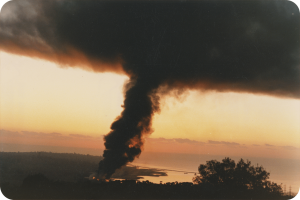
Photograph of the Dora Port Explosion taken from Bsalim by ecotoxicologist, herbal pharmacologist and environmental activist Dr. Pierre Malychef on the morning of March 30th, 1989
“ولا من الواضح أي بيئة ستبقى من هذا البلد اذا كان الوزير المختص لم يكلف نفسه اكثر من عناء ابداء الاستغراب في مواجهة اعتراضات الناس، كأن المطلوب من المواطنين أن “يموتوا” ثم يعترضوا. في حين أن استقالة وزير او اقالته لا تحتاج في بلاد العالم الى هذا القدر من البراميل والروائح الكريهة التي تهدد الناس وتزعجهم. … والمسألة في النهاية ليست مسألة “مستوعب للرعب” يربض الآن في بيروت، وانما مسألة “سياسة الرعب” قد تصنع وطناً يرعب ابناءه.”
Nor is it clear which environment will remain in this country when the minister that is specialised in its care didn’t bother himself to any action beyond expressing surprise in the face of people’s objections, as if citizens are required to “die” and then object. Whereas, in the countries of the world, the resignation or dismissal of a minister does not need that amount of barrels and stench toxic smells that threaten and disturb people’s lives. […] At the end of the day, the issue at stake is not “a container of horror” now sitting in Beirut, the main issue is a “politics of horror” which produces a state that horrifies its people.
Rajeh Alkhoury, “A Container of Horror in Broad Daylight”, Annahar Newspaper, September 1, 1994
✺ سيكون هذا النص متاحاً للقراءة وللاستماع باللغة العربية وبصيغة صوتيّة في غضون شهر. ✺
This horror cannot be contained. While grappling with an exilic, eruptive violence that is no longer slow, I shall begin with a threefold commemoration. This research series is humbly initiated in the mournful, loving memory of all the victims of the Beirut Port Explosion; those who left us in indelible loss and infinite rage; and all the injured who remain with us 1 – many of whom with concealed wounds that were never located nor counted. I’m always thinking of you and the forthcoming generations. I wholeheartedly hope posterities won’t be born like us, into a toxic, explosive environment and global economy of war that compel us to attempt to recuperate our lives everyday. The deeper I delved into this research, the less information I was able to find about the rapidly increasing multi-specific victims who fell and continue to fall in epistemological and neurotoxic amnesia from scores of deliberate and accidental detonations, as well as, exposomes of anthropogenic ammonium compounds. I dedicate this research to your unnamed memory. Finally, this series and this platform come to life in honour of the nurturing legacy of ecotoxicologist, herbal pharmacologist and environmental activist Dr. Pierre Malychef(1925-2014) whose timely investigations have been generously and diligently guiding my environmental work in the last 10 years.
As first step towards better understanding both of the short-term and long-term environmental impacts of ammonium nitrate, I found myself drawn to explore its manifold historical origins and intricate pathways of circulation. In this pursuit, it was crucial to retrace its origins to its naturally occurring form previously known as “nushadir” in Arabic and sal ammoniac in Latin(equivalent to “ammonium chloride”) 2 , meticulously examining its diverse historical applications and trades in the realms of alchemy and science. To better prepare myself for that long delve, I wondered what was the aetiology of its name? Perhaps I should just start there and then parse out and draw up? To my surprise, or rather to further corroborate the collective discombobulation I was in, the etymology of “ammonium nitrate” signified: the hidden compound without life.
Preceding its association with the negation of life, “ammonia” owed its name to the ancient Egyptian deities Amon and Amonet, whose names meant “the Hidden One”. In the ancient Egyptian priest and priestess orders of Amon, ammonium was considered a sacred mineral, derived from burnt animal dung, and used ritualistically to revive with its pungent vapors those who had lost consciousness – and thus lost their souls – back to life. Representing the concealed realms that just as the wind can be felt but not seen except through its whopping effects, Amon was often depicted with blue skin to denote invisibility and primeval creation. 3 Representing the invisible nature of the chaos-void that existed prior to Earth’s creation, Amonet and her primordial partner, Amon, were the only two primeval gods of the sacred Hermopolitan “Ogdoad”, the group of eight, whose prominence was retained throughout several dynastic periods. Starting the 18th dynasty, Amonet, also known as “Amauni” and the protectress of the pharoahs, would eventually dwindle in syncretism with the goddess Mut, and Amon, the protector of the rights of the poor in courts of law 4 , would continue his passage into the ages becoming the chief Greek god Zeus Amon and the Roman Jupiter Amon.
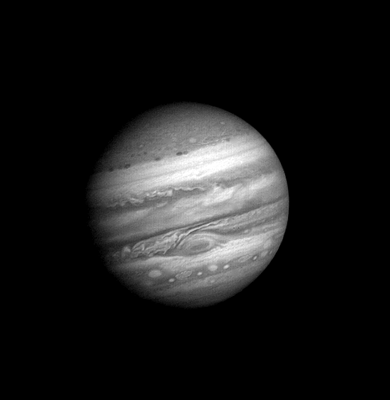
Timelapse of Jupiter’s cloud system moving over the course of one month, taken during the Voyager 1 flyby in 1979 (Source: NASA)
Less than a century ago, in 1932, astronomer Rupert Wildt identified absorption bands of ammonia and methane within Jupiter’s spectra 5 . Today, it is well established by scientists that Jupiter’s atmosphere is perpetually covered by ammonia crystal clouds. Forming swirling bands in the tropical regions of its tropopause layer, Jupiter’s clouds of ammonia might possibly also contain ammonium hydrosulfide whose non-aqueous form is occasionally used on earth for photographic processing, textile manufacturing and applying patina to metal alloys. These tropical regions generate year-long storms and turbulence due to conflicting circulation patterns, with zonal jet streams reaching wind speeds of up to 100 meters per second. 6 The cloud layers, consisting of two decks of thunderous ammonia, extends to a depth of approximately 50 km. They might interstitially hold a thin layer of water clouds underneath, contributing to thunderstorms whose electrical discharges can be up to a thousand times as powerful as lightning on Earth. A well-known attribute of Jupiter, possibly since 1664-7, is its persistent anticyclonic storm known as The Great Red Spot. 7 Ultraviolently irradiated acetylene and ammonia are thought to be the main drivers making up the Great Red Spot’s crimson chromophore. 8 This reddish storm produced by UV light interaction is the result of a process called photolysis, i.e. the decomposition or separation of molecules by the action of light. In the last decade, scientists have keenly observed the spot as it dynamically changed its hue from a pale orange to a darker, deeper red, concluding that this might signal towards an increase in the supply of acetylene and ammonia. But what is the lifetime of this rufous storm that has never ended since, at the very least, the time when we have visibly observed it? The indelible weather of geotrauma.

Detailed image of Jupiter’s Great Red Spot, taken by the Juno spacecraft flyover on July 11, 2017 (Source: NASA)
It was around the oracular Temple of Amon/Jupiter(simply dubbed in Arabic as “معبد التنبؤات”; “The Temple of Prophecies”) in the Siwa Oasis of present day Libya that some of the earliest accounts of ammonia were noted down to us. Well documented by Pliny, Arrian, Columella, Su Jing, Al-Muqaddassi, Ibn Hawqa and Newton, among others, the uses of ammonia across millennia ranged from ritualistic, medicinal, manufacturing and alchemical purposes. Naturally also found around volcanoes and self-burning coal seams, sal ammoniac was commonly used to stabilise and extend the life of anthropogenic temperatures for a variety of purposes that were most frequently mystical. As 2nd c. Chinese alchemist Tshan Thing Chhi desprictively puts it, “mending a cauldron with ice [would be] like bathing a boil with sal ammoniac, or driving away cold with ice”. 9 Beyond the bathes in Alexandria that were known to be a seminal, recurrent source for the North African, West Asian and Mediterranean trade of ammonia through the combustion of camel dung, Zoroastrians and Mithrains would use the scatological and volcanic substance to create eternal coal fires. Despite the multiple persecutions and fatalistic assaults that these trans-millennial cultures went through, The Fire Temple in Persepolis remains standing today as a ruin-witness to these adorable fire practices. It is from this Zoroastrian naming of ‘Anosh Adur’ meaning ‘immortal fire’ that the Arabic word for “ammonia”; ‘nushadir’, was derived. 10 This text is the first part of a research series that investigates the trans-millennial history and political ecology of ammonia across multiple times, economies and cultures of combustion, production, extraction, trade, usage and meaning. Researched and written with the timely goal of better understanding the political economy and environmental impacts of the Beirut Port Explosion, this first part will be introducing the material lineage of ammonia while honing in on the industrial and militarised usage of nitrogen-fixated ammonia during the 20th and 21st century. Ensuing parts in this series will thoroughly revisit accounts of its alchemical, ritualistic and medicinal usages while continuing to probe and call for furthering the study of its political ecology in the realms of agriculture, public health and war.
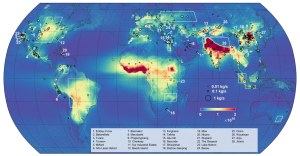
World map of atmospheric ammonia fluxes based on IASI satellite data collection from outer space. The measurements were taken between 2008 and 2016, showing 242 hot spots, surrounded by black circles, and 178 wider emission zones, framed by white rectangles. (Source: Martin Van Damme and Lieven Clarisse and the Université Libre de Bruxelles (ULB))
In the last century, the vast atmospheric emissions of anthropogenic ammonia have been leading to acidification and biodiversity loss. Environmental physicists of the last decades have been repeatedly warning of several deficiencies , blindspots and loopholes within the missing quantifications and (under)study of modern ammonia emissions and their environmental and public health impacts. 11 We have already seen how ammonia gas is plentiful and universal. Here on Earth, it has been mostly formed when vegetable matter decays, and hence even the air we breathe often contains considerable quantities of it. But how did we corrupt this ubiquitous gas into some of the most dangerous explosive compounds that weaponise the earth, erode the soil and risk making our lives and crops monocultural?
Throughout the 19th century, the demand for nitrates and ammonia for use as fertilizers and industrial feedstocks rapidly increased in imperial Europe, whose primary supply relied on the extraction of niter deposits and guano mining from Chile, Peru and multiple islands in the Pacific. 12 Many reserves were already mined to the brim by the end of century, so imperial concerns arose about the insufficiency of existing reserves to meet future demands, leading to intensified research into alternative sources. Despite the abundance of atmospheric nitrogen (N2), constituting ca. 78% of the air, its exceptional stability hinders reactivity with other chemicals. In order to convert atmospheric Nitrogen into ammonia so it can be absorbed by other organisms, nitrogen needed to be “fixated” in the laboratory.

Guano comes from the trans-millennially accumulated excrement and remains of birds, bats, and seals, and it was ravenously valued as imported fertilizer in 19th century US and Europe. Taken by Alexander Gardener in 1865, these images depict the extractive and exploitative process of guano mining in the Chincha Islands of Peru. The mining was carried through forced labor from hundreds of thousands of South American prisoners, enslaved and indentured workers from Hawaii and China. This massive extractive industry of shit reflects a lot of the duping violence of the European Colonial Project across the world. For instance, in 1852, a significant maritime mutiny occurred, involving four hundred indentured Chinese workers who rebelled against their captor, Leslie Bryson, a Connecticut businessman and slave trader. Bryson had deceived these workers from mainland China, luring them under the pretext of opportunities in San Francisco, when in reality, their destination was the guano islands of Peru. All of this makes me wonder about the links between the global slave trade, the abolition of slavery and the militarised development of industrial fertilisers. By the late 1870s, nearly all of the Chincha Islands guano was gone, and the seabird habitat was ruined by the mining operations.
In 1909, German physical chemist Fritz Haber devised with his student Robert le Rossignol an apparatus that uses osmium and uranium catalysts for the synthesis of ammonia from its elemental constituents, hydrogen and nitrogen, at a pressure of around 175 atmospheres at 550ºC. Four years later and just one year prior to WWI, in September 1913, Haber joined forces with industrial chemist Carl Bosch at BASF to create the Haber–Bosch process, the main industrial procedure for the production of ammonia. Nitrogen fixation became possible, and the German nationalist Fritz Haber who was also dubbed as “the father of chemical warfare” for his years of pioneering work developing and weaponising chlorine and other poisonous gases during World War I, won the Nobel Prize in Chemistry in 1918 to honor his invention of the Haber-Bosch process. Several political history theories abide, linking the advent of World War I to the food autonomy that Germany gained through the Haber-Bosch process. In 1914, Germany was allegedly no longer in fear of the risk of famine(although at the end of the First World War, famine did rage in Germany), nor was it dependent anymore on food imports coming from the occupied lands via Britain. Although ammonium nitrate’s explosive nature was widely known and deployed from the very beginning of nitrogen fixation, since it had been extensively employed for military purposes during World War I, this didn’t stop it from becoming a massive profit-mongering, monocultural economy that has been in perpetual expansion until today.

Fritz Haber on the Western Front in World War I, instructing German soldiers on the use of chlorine gas. (Source: Archiv der Max Planck Gesselschaft, Berlin)
Dr. Jozef Visser studied chemistry in the 1960s and worked as a chemical engineer for several decades. When he reached his 50s, he decided to bring his work into a halt and return to university in order to conduct this timely decade-long research at the intersection of soil science, philosophy of technology and history of science. His 600 pp dissertation with 3300 references was entitled ‘Down to Earth’ (Wageningen 2010), offering a ‘historical-sociological analysis of the rise and fall of ‘industrial agriculture’ and the prospects for the re-rooting of agriculture from the factory to the local farmer and ecology’. 13 While preparing to delve into this research, I read his doctoral thesis and some of his published papers, learning profusely about the soil nutrient depletion that industrial ammonia plants and the political economy it upscaled. In hopes of better understanding the possible environmental impacts of the Beirut Port Explosion, I reach out to him for an interview request in September 2020. Dr. Vissers seems very warmly accommodating, and we share a brief email correspondence before our call,
“There are so many “forgotten publications” that your generation will have quite some work in bringing some order to it all. Maybe the most important conclusion from my research of many years is that the slogan “thanks to industrial fertilizer we can feed the world” has no substance. For example the use of biological nitrogen fixation, both free and symbiotic, is in principle quite sufficient so that we don’t need the ’nitrogen fixation industry’ with its explosive products… This industry was established during & after WW I thanks to the injection of enormous finances by the government, and soon, it was difficult enough to obtain finances for research (into crop nutrition) from other sources. When after WW II, the government and industry united in prescribing the use of industrial fertilizers, independent research became quasi-impossible. That was difficult enough, of course, but more problematic still was how, in this way, concepts and methods became ‘standardized’, making alternative approaches ‘invisible’. Of course that was not absolute: many of the ‘standardized’ concepts and methods are in discord with chemistry. This is the reason why a long time ago already, I, as a chemist, started questioning the peculiar discipline.”
At the beginning of our call, Dr. Visser and I delved into how during WWI, WWII and the post-war years, the power of industries over universities grew immensely. I call that the techno-military-industrial-academic complex, and he calls it the government industrial complex, and we both knew well that we are speaking of the same ecocidal power of knowledge atrophy. “Humility, what a researcher really needs is humility”, he gently tells me on the phone, and I can’t agree more. I also note that down and think to myself; how do we, each one of us, reproduce and feed the military-government -industrial complex, researchers, researched or not? How can we unlearn and demilitarise at each and every scale? Dr. Visser speaks of “knowledge erosion” and “the truth in the field” in direct contrast to the economy of organic chemistry from the mid-19th c. to the world wars and the present. All of this reminds me of the multi-centennial land struggles and food medicine of indigenous communities, أهالي الأرض, the indelible wisdom of my grandmothers and the collective, deeply remediating return of my fellow citizens in Lebanon to agriculture in light of the present economic crises. “When the Food and Agriculture Council was established in the US post-WWII, this was done without the input of farmers”, Dr. Visser continues over the phone, “and this is how you deny the need of organics, scale up, spit up and specialise. It was not just the rise of a ‘Military Industrial Complex’ that endangered the life of the nation, but also the all-out transformation of the socio-economy to one dominated by big industry and government in their ‘revolving door’ unity.” When I bring up the medical effects of nitrate contamination and overuse, like in the case of Blue Baby Syndrome where drinking nitrate-contaminated water 14 leads to oxygen deficiency in the blood of infants, Visser responds, “the medical problems are bigger, but this strand of research lacks financing and remains very scarce. Recent research prove a link between nitrogen contamination and neurodegenerative diseases 15 , and it could be even more than that.”
In an interview with Lifespan and ScienceDaily around the substantial link between increased levels of nitrates in our environment and food with the rise of Alzheimer’s, diabetes mellitus and Parkinson’s, Dr. Suzanne de la Monte, MD, MPH, of Rhode Island Hospital and professor of pathology and lab medicine, says,
“We have become a ‘nitrosamine generation’. In essence, we have moved to a diet that is rich in amines and nitrates, which lead to increased nitrosamine production. We receive increased exposure through the abundant use of nitrate-containing fertilizers for agriculture. Not only do we consume them in processed foods, but they get into our food supply by leeching from the soil and contaminating water supplies used for crop irrigation, food processing and drinking.”
Nitrites and nitrates, as chemical compounds, have been scientifically shown to possess deleterious effects on the health of humans and other animals. The study that Dr. de la Monte led shows that 90% of examined compounds within this class have been identified as carcinogenic, impacting diverse organs. 16 These substances are prevalent in numerous food items, encompassing cured meats, fried bacons, industrial cheese products, as well as beer and water. Exposure may also arise during the manufacturing and processing of rubber and latex goods, as well as through the utilization of fertilizers, pesticides, and cosmetics. What about the medical and environmental impacts of the 2,750 tonnes of ammonium nitrate that detonated in our city? We can’t stress enough the need to urgently and regularly study them for many generations to come. Not only trauma is neurotoxic.
Ports are, by essence, militarised spaces of trade. We can’t forget that, yet many of the ammonia remain-ed unknown. The (continuously) violent time before I was born that I would have imagined my parents to have certainly remembered haunted me when, in 2022, I found these photographs in the remnants of the domestic laboratory of late chemist, ecotoxicologist, herbal pharmacologist and environmental activist Dr. Pierre Malychef. Language flees in revelations like these, superseding memory and the pain of dismembered recurrence:

A photograph I developed from a roll of negatives found in the domestic laboratory of ecotoxicologist, herbal pharmacologist and environmental activist Dr. Pierre Malychef. Malychef has written on the envelope’s roll “INCENDIE DORA” showing images that were all taken on the March 30th, 1989, documenting the dark grey smoke, molten oil and gas tanks.
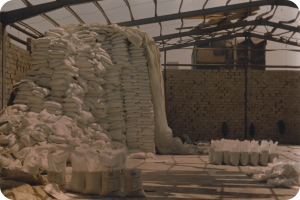
A closer view within the aforementioned hangar, showing 5 frontal sacks with the same “Ammonium Sulfate, BASF, made in Germany” mark as in the first close up portrait view.
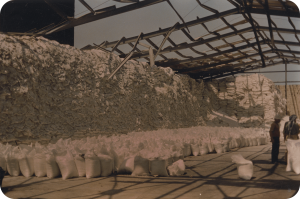
Image from the same roll of film that Malychef had developed and taken in 1989. The photograph shows workers in a destitute hangar with a pressure-torn room post-explosion. Similarly to Hangar 12, the hangar is filled with white sacks, akin to the ammonium nitrate sacks we all became familiar with in the last 3 years.

Image of a 50 KG sack of Ammonium Nitrate taken and developed by Dr. Pierre Malychef at the Dora Port, on March 30th 1989.
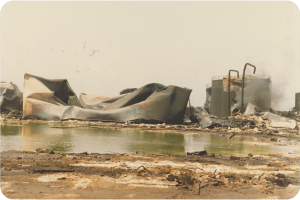
Image from the same roll of film taken and developed by Dr. Pierre Malychef showing molten oil tanks after they exploded on March 30th 1989 at the Dora Port. Smoke is still fuming and a murky water fills the ashen ground of the port.
These images and sacks of Ammonium Nitrate and Ammonium Sulphate are not from 2020, but from 1989. This port is only 7.6 km from the Beirut Port; the Dora Port that holds a lot of Lebanon’s energy and oil infrastructure. These sacks of industrial ammonia explosives were also stored in a hangar so uncannily similar to Hangar 12, but they did not explode.. This smoke doesn’t belong to the ammonia. Even if they were stored a couple of meters away from the site of one of the biggest explosions of the Lebanese Civil War(1975-), as far as indicated in the images, in the chromophores of the smoke and the testimonies I was able to collate, they did not detonate. As your words are most probably evanescing with mine in a 34-year old deterred yet protracted mourning, I will let the images below evince their power of attestation:
First of all, I would like to pause, take a collective breathe and grieve with all of us. I mourn the casualties whose names I wasn’t able to find in these atrocious, trans-generational war games and remember the deaths that were not even enumerated. Horrified, humbled and deeply indebted to the timely legacy, devotion and courage of Dr. Pierre Malychef, I relay my most heartfelt condolences to the myriad survivors whose memories I had so wished to hear. I mourn the unnamed, the horrified, the collective amnesia, the erosion of our truths and memories and the unknowns in our truths. I mourn enraged and dispossessed with a torn collective memory I wholeheartedly hope we can recover, so we can finally gather towards healing. I mourn and remember that healing cannot take place if our environment remains the same; ارثي واتذكر يوميّاً كيف حرب أهلي لم تنتهي بعد.
On February 24th 1989, after a two-week long offence between the Lebanese Forces and the Aoun-led army brigades, the Lebanese Forces agree to hand over the fifth basin of Beirut Port to General Aoun and his army. After the Phalangists took over the Beirut Port at the end of the Battle of the Hotels in March 1976, The Lebanese Forces war militia turned “political party” controlled the 5th basin of the Beirut Port, incurring great profits from tax revenues and the import of arms and toxic waste. Two weeks later, on March 8th 1989, Michel Aoun’s patrol boats intercept a boat bound for the PSP-controlled port at Jieh, triggering a series of indiscriminate artillery barrages, with Amal forces shelling the East Beirut Port and Jounieh Port, while Aoun’s army brigades shelling Souq El Gharb. Dubbed as the onset of ‘The War of “Liberation”’, I think it should have been rather called the ‘War of the Ports’.
On March 30th, 1989, at approximately 1:15 a.m., the Syrian regime bombshells the Dora Port. A row of TOTAL tanks containing diesel fuel explode, resulting in a series of devastating fires. The tanks were engulfed in flames, causing the fuel to leak onto the ground and ignite on the seawater’s surface. The fire quickly spread to the cooling water on the tank floor, intensifying the combustion process and creating a cascading effect. Efforts to control the blaze proved futile as the flames wrapped around the gas tank and its 13 meters-wide cover was dislodged, unleashing a tremendous amount of heat that overwhelmed any cooling mechanism in place. Of utmost concern was the 30 tons of hazardous propane gas that the neighbouring tanks held approximately. The sky was clad with cloud masses of black smoke, resulting from the combustion of gasoline mixed with oils and kerosene. 7 hours and a half later, at 8:53 a.m., the gas cloud rose vertically into the air due to the absence of air currents and collided with a mast torch, triggering the massive, pictured explosion that reverberated along the Lebanese coast from Batroun to southern Sidon and reached as far as the mountainous regions of Batroun, Metn, Barouk, and Chouf. Similarly to August 4th, 2020, several earwitnesses spoke of hearing the sound of the end of world and witnessing the earth quaking with an ineffable magnitude. Experts began comparing the catastrophe to a nuclear detonation and nearby hospitals fell to the floor. 17
A snippet from a TV report produced and relayed on March 30th 1989 by the Lebanese Broadcasting Corporation, LBC. Trigger Warning: the video shows the moment of the explosion with the voice over of an aghast father shocked with the blow, trying to comfort his crying children while grappling to make sense himself of what he is witnessing. We hear a reporter’s voice saying in Arabic, “The was the moment of the explosion. This is how the the shape of the smoke changed forms after the explosion. As you see, the smoke has morphed into the shape of a mushroom cloud, as if it were a nuclear explosion.”
The force of the explosion propelled the tank cover, which had a diameter of 13 meters, through the air and caused it to strike the power transmission station in Baouchriye Dam. As a result, three high-voltage lines were severely damaged. Two of these lines, each carrying a power of 66 kilovolts, connected the Zouk thermal plant to the Baouchriye transmission station, which then supplied electricity to Beirut through the Bsalim station. The third line, with a capacity of 160 kilovolts, linked the Baouchriye station with the Jamhour station. The collision led to a complete outage of electric power in Beirut, causing widespread disruption. The incident should have raised transformative, serious concerns about the safety measures and protocols in place at industrial coastal facilities, especially those handling dangerous fossil fuels. Still to this day, no thorough investigation was conducted into the cause and impacts of the explosion. New gas and oil tanks were reinstalled in place of the old ones, and high energy tanks, just a couple of hundred meters from highly dense residential areas, continue to expand until today at the Dora Port. 18 Just last year in 2022, Unigaz began works to install a new, massive tank not far from from the 1989 explosion. 19

Image taken by Dr. Pierre Malychef on March 31st 1989, showing bent and broken electricity transformers at the Bsalim Power Station, as one of the many collateral damages that shook neighbouring cities as a result of the Dora Port Explosion. The Bsalim Power Station is located 7.2 km away from the explosion site and is one of the most equipped and connected electricity stations in the Matn district. On June 24th, 1999 and on May 5th, 2000, Israeli warplanes bombed the Bsalim Power Station. 20
But what about the sacks of ammonium nitrate from 1989? They did not explode, and I did not find any mention of them from 1989 beyond the photographs taken by Dr. Malychef. As a scientist, Malychef understood well the catastrophic consequences of the ammonium nitrate catching fire in this maddening domino effect. Despite the regular coverage of the Beirut Port Explosion by the international media, they have failed to adequately represent the prevailing local public opinion or discursively allow any room for considering the possibility of the explosion being deliberate. However, within Lebanon, there is a growing consensus within the public, scholarly circles and the media around the likely deliberateness of the Beirut Port Explosion. We cannot rule out this probability without a thorough investigation. The port has always been militarized, and our infrastructure has been frequently both targeted and threatened by militarised forces of occupation, whether internal or external. The 1989 Dora Port Explosion where sacks of ammonium nitrate and ammonium sulfate did not explode, despite the cascading effect of several explosions in its vicinity, insinuates further the potentiality of a targeted infrastructural attack in 2020. We urgently need a locally-led independent international investigation committee to be formed to reinstate and foresee the investigation of the Beirut Port Explosion. This investigation committee needs to understand well the histories, wiles and strategies of war, the science and social science of ecocide and the tropes of slow and eruptive violence in the Global South and in the global economy. It surely cannot be formed or overseen by former war militia leaders that never faced the law with their increasingly deadly legal immunity. After all we have been through, we urgently need an actualization of a politics of remedy, access and de-toxification in Lebanon and in the world, and this cannot come from state criminals of war that occupy us since حرب أهلي.
For as long as I can remember in this weaponised Earth I was born into, I tried so hard to deal with hidden, denied, neglected and concealed matter. Obviously, I am still trying to do that in here. Where I come from, and in toxic jurisprudences at large, the investigator is the criminal, the witness is the sacrifice and the criminal is the judge. From since as long as I can recall, I, just like the collective in Lebanon, have been a witness to the weaponization and degradation of our environment, and all the state obfuscation and gaslighting that enable that in both slow and eruptive negations of life. My fascination with science and the hidden were kindled by embodied urgencies, a secretly contaminated life. I grew up in Sahel Alma, three minutes from the quarry where over 6000 barrels of toxic waste have been imported from Italy, stored and in many instances, detonated and burnt until they were buried under the ground. Interred in the vicinity of the highly interconnected groundwater channels of my hometown, this toxic waste remain earthed up today under the depleted mountain neighbouring our homes. This case has been occupying me for nearly half of my life. Profit-mongering toxic abandonments are all too familiar for my community and myself. I will not rest until the waste is removed, and until the toxic environment that was buried or burnt along with the waste is detoxified and rehabilitated with the utmost collective care.
The criminals who brought in, buried, burnt, and let the ammonia detonate in ports and mountains, and interred toxic waste in our environment need to be held accountable in people’s tribunals — in an active legal apparatus, one that can take nation-states to court — and even under multiple judicial systems at once. These environmental war criminals should be made to confess and guide us to the places they traded and contaminated, so that we can unbury the hidden matter that they were bribed to poison us with in their war and “post-war” games. With the ammonium nitrate, they have injured and massively killed the inhabitants of Beirut and with the toxic waste, polluted and produced under-examined terminal illnesses and diseases in my hometown. The Lebanese state is still deploying the very same agnophillic tropes and strategies of denial, falsification, chemical massacre, and infrastructural gaslighting with the Beirut Port Explosion as previously exploited in forcefully shutting down the investigations around the imported toxic waste and in granting amnesty to over a decade of a war that still occupies us inter-generationally. The Lebanese judiciary is following the same enduring toxic ontology that Lebanese Civil War-born militias all abide by, where the investigator is falsely made to be the criminal, and the criminal is made to be the false judge, in a kleptocratic and ecocidal state.
I recall here a snippet of what ecotoxicologist, herbal pharmacologist, and photographer Pierre Malychef said in a radio interview in September 1998, three years after the Lebanese government shut down the investigation, by force, once again:
“I was finding all this toxic material so quickly. It became a real problem for the Lebanese Forces. If the government returned the toxic waste to Italy, then the Lebanese militias would be obliged to return a big part of the money they got for taking the toxic waste in the first place. This didn’t make them very happy, and they retaliated against me.”
Malychef was one of three official investigators of the toxic waste trade. Instead of entrusting and supporting the timely, environmental knowledge Malychef produced and stood for, the herbal pharmacologist and environmental caretaker was repeatedly, violently assaulted, falsely accused of perjury “شاهد زور” and sacrificed as pharmakon by the militia-state.
In 1995, at the age of 65, Malychef was detained by a farce-like jurisprudence, just one day after Said Mirza was abruptly appointed by the government as a new prosecutor on this case. Mirza, who in the ensuing years would become notoriously known as “قاضي شهود الزور” the judge of false witnesses, scapegoated a scientist as a “false witness” for collating and presenting scientific evidence in a governmental investigation that he was officially assigned to co-investigate. Before that, Malychef was physically assaulted twice by members of the Lebanese Forces, once in 1988 at the Beirut Port, and a second time in Bsalim in 1995, in broad daylight. In 1996, Malychef’s home was secretly raided by the Mossad who threatened his life for writing about the toxic and biohazardous medical waste that Israel was, and is still, dumping in the Southern seas of Lebanon in Tyre and Sidon.

Subordinate militia men managing an illegal quarry whose environmental impacts Pierre Malychef has been investigating and publishing against, planted a bomb in the mid-1980s in his first pharmacy in Jal el Dib. The bomb was luckily detonated in Maychef’s absence. This image shows Malychef standing in front of the collateral damage.
Malychef has generously and trans-generationally guided me over the past decade in researching ecocide in my hometown. Thanks to his deep care for the environment and diligent knowledge production, we have abundant evidence of the urgency to reopen the criminal toxic waste trade investigation and continue the Beirut Blast investigation in a new, recurrent light, this time with multi-generational collective demands, plans, and actions for environmental decontamination.
In a maddening criminal kleptocratic state, we are all terrorized, poisoned, bereaved, and accused of being false witnesses. For us the poison is real; it is a weapon we know well though it reeks hiding around our homes, seas and global economy. It has transpierced into our skin; it killed our families both slowly and eruptively; it still hides in our water and bodies, understudied and denied. Are there more containers of ammonium nitrate and of similar weaponised amons still secretly lurking in our midst? Just like the toxic waste that still abides under the poisoned ground of my hometown, these concealed matter of chemical warfare should be urgently removed by those who produced, bought, stored and interred them. We can never stop investigating the toxic history in our environment, bodies and global economy, even after we have decontaminated and rehabilitated our towns, quarries, and landfills. Many of the expired chemical waste stored, buried and detonated in our environment produce exposomes that outlive us.
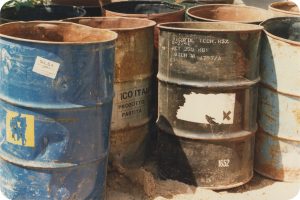
Image taken by Dr. Pierre Malychef of a group of barrels from the ca. 15,800 barrels carrying the toxic waste trade. Some of the worn barrels contained Dicofol, a highly toxic pesticide whose production and use are banned internationally under the Stockholm Convention. Dicofol is a nerve poison that can also lead to skin and eye toxic reactions in humans and endamage the fertility of several birds, reptiles, aquatic invertebrates and algae. Since Dicofol can be stored in fatty tissues, intense activity or starvation may re-catalyze the chemical, resulting in the reappearance of toxic symptoms long after actual exposure.
Down the line in this linguistic, phylogenetic and etymological quest for the roots of ammonia, I noticed another possible lineage. I speculate a plausible link between the Egyptian Amon and amn; “أمن” in Arabic, the word used in modern times to denote “security/security forces”. This likely genealogy that I would love to leave you with as penultimate reflection does not connote the modern securocratic, systemic and forceful interpretation of the word. I would argue that amn in this case would be closer to what e’timan “ائتمان” stands for today – the trust in confiding that emerges out of a great devotion to care, not fear and to preservation, not dispossession. It took me some years to figure out a way of how I can preserve the urgent environmental legacy of Dr. Pierre Malychef and share it with you all as public property. And now, here it is in this cartography of darkness; available for everyone’s use and circulation as we continue to search for environmental justice. All generations will remember as we de-militarize our environment, renew our energy and seek to collectively grasp together the memories that silently haunt us in between deaths. Unbury the waste, unbury the amons.
🛢️🛢️🛢️
